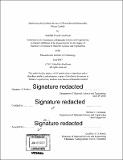Optimizing the synthesis process of wood-derived biomorphic silicon carbide
Author(s)
Alsalloum, Abdullah Yousef
DownloadFull printable version (6.787Mb)
Other Contributors
Massachusetts Institute of Technology. Department of Materials Science and Engineering.
Advisor
Michael J. Tarkanian.
Terms of use
Metadata
Show full item recordAbstract
Biomorphic silicon carbide, a porous, light and high strength ceramic typically derived from natural wood, has great potential in high temperature and structural applications. Over the past several years, researchers have developed three main routes to fabricating biomorphic SiC: reactive infiltration of molten Si, chemical vapor infiltration of Si or SiO, and SiO₂-bearing solution infiltration. In this study, the latter was investigated and optimized. In addition, a novel synthesis technique, Si suspension infiltration, is proposed that overcomes the major issues present in the current methods. Four wood species (balsa, pine, maple and oak) offering a wide range of porosities were infiltrated with colloidal SiO₂ under varying pressure conditions, and the corresponding weight gains were recorded and studied. The samples were then fired at 1600 °C for 2h under argon flow, and examined via X-ray diffraction (XRD), scanning electron microscopy (SEM) and compression testing. It was found that applying pressure or vacuum produced more effective SiO₂ weight gains. Pine showed superior absorption to other types with its maximum obtained value achieved under vacuum followed by pressure. The starting concentration of SiO₂ solution proved to be crucial in controlling the final mechanical properties of the specimens. XRD analysis revealed that the resulting samples consisted of nearly pure SiC, and SEM images indicated that the initial structure of wood was retained. Due to the nature of the reactions involved with using SiO₂ as a-precursor, the produced specimens tend to be mechanically weak. The new synthesis approach involves the use of <10 pm sized particles of Si instead of nano-sized SiO₂ particles. Pine was selected to serve as the template for absorption, and after two infiltration treatments, the sample absorbed 55.6% of its weight, ~4% higher than its theoretical stoichiometric need, 51.3%. EDS analysis revealed that Si was able to spread homogenously, and XRD spectra confirmed the material identity to be composed of mainly pure SiC with minor trace metal contamination. Compression testing illustrated better mechanical properties of the Si prepared specimen, suggesting the potential of this method to replace existing techniques.
Description
Thesis: S.B., Massachusetts Institute of Technology, Department of Materials Science and Engineering, 2017. Cataloged from PDF version of thesis. Includes bibliographical references (pages 41-46).
Date issued
2017Department
Massachusetts Institute of Technology. Department of Materials Science and EngineeringPublisher
Massachusetts Institute of Technology
Keywords
Materials Science and Engineering.